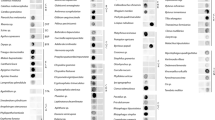Summary
Telomere-associated DNA inChironomus pallidivittatus contains tandemly repeated 340-bp units. We show that they are distributed among several subtypes of which we have characterized two, M1 and D1, with regard to base sequence, homogeneity, and intertelomeric distribution. Each subpopulation is highly homogeneous and the two subtypes have identical consensus sequences throughout 90% of their lengths. In the remaining part the homology is only about 60%. Each subpopulation has its specific intertelomeric distribution and there is no difference in the degree of homogenization within and between telomeres. The repeat unit contains two pairs of subrepeats embedded in linker DNA. This provides a model that makes it possible to relate the two subtypes to each other with regard to evolutionary history. The difference between the two subtypes is due to mutations that have occurred in only one of them, D1, resulting in a decreased similarity between one of its pairs of subrepeats. This type of repeat unit is therefore believed to be derived from the other, M1. The local decrease in similarity between M1 and D1 suggests that homogenization between them occurs by gene conversion.
Similar content being viewed by others
References
Biessmann H, Carter SB, Mason JM (1990) Chromosome ends inDrosophila without telomeric DNA sequences. Proc Natl Acad Sci USA 87:1758–1761
Carmona MJ, Morcillo G, Galler R, Martinez-Salas E, de la Campa AG, Diez JL, Edström J-E (1985) Cloning and molecular characterization of a telomeric sequence from a temperature-induced Balbiani ring. Chromosoma 92:108–115
Dover GA (1982) Molecular drive: a cohesive mode of species evolution. Nature 299:111–117
Fedoroff NV (1979) On spacers. Cell 16:697–710
Flavell RB (1986) Repetitive DNA and chromosome evolution in plants. Phil Trans R Soc Lond B 312:227–242
Jeffreys AJ, Neumann R, Wilson V (1990) Repeat unit sequence variation in minisatellites: a novel source of DNA polymorphism for studying variation and mutation by single molecule analysis. Cell 60:473–485
Krystal M, D'Eustachio P, Ruddle FH, Arnheim N (1981) Human nucleolus organizers on nonhomologous chromosomes can share the same ribosomal gene variants. Proc Natl Acad Sci USA 78:5744–5748
Langer-Safer PR, Levine M, Ward DC (1982) Immunological method for mapping genes onDrosophila polytene chromosomes. Proc Natl Acad Sci USA 79:4381–4385
Nielsen L, Schmidt ER, Edström J-E (1990) Subrepeats result from regional sequence conservation in tandem repeats inChironomus telomeres. J Mol Biol 216:577–584
Renkawitz-Pohl R, Bialojan S (1984) A DNA sequence ofDrosophila melanogaster with a differential telomeric distribution. Chromosoma 89:206–211
Rubin GM (1977) Isolation of a telomeric DNA sequence fromDrosophila melanogaster. Cold Spring Harbor Symp Quant Biol 42:1041–1046
Saiga H, Edström J-E (1985) Long tandem arrays of complex repeat units inChironomus telomeres. EMBO J 4:799–804
Sanger F, Nicklen S, Coulson AR (1977) DNA sequencing with chain terminating inhibitors. Proc Natl Acad Sci USA 74: 4463–5467
Scalenghe F, Turco E, Edström J-E, Pirrotta V, Melli M (1981) Microdissection and cloning of DNA from a specific region ofDrosophila melanogaster polytene chromosomes. Chromosoma 82:205–216
Smith GP (1976) Evolution of repeated DNA sequences by unequal crossover. Science 191:528–535
Strachan T, Sodoyer R, Damotte M, Jordan BR (1984) Complete nucleotide sequence of a functional class I HLA gene, HLA-A3: implications for the evolution of HLA genes. EMBO J 3:887–894
Strachan T, Webb D, Dover GA (1985) Transition stages of molecular drive in multiple-copy DNA families inDrosophila. EMBO J 4:1701–1708
Young BS, Pession A, Traverse KL, French C, Pardue ML (1983) Telomere regions inDrosophila share complex DNA sequences with pericentric heterochromatin. Cell 34:85–94
Author information
Authors and Affiliations
Rights and permissions
About this article
Cite this article
Cohn, M., Edström, JE. Evolutionary relations between subtypes of telomere-associated repeats inChironomus . J Mol Evol 32, 463–468 (1991). https://doi.org/10.1007/BF02102648
Received:
Revised:
Issue Date:
DOI: https://doi.org/10.1007/BF02102648




